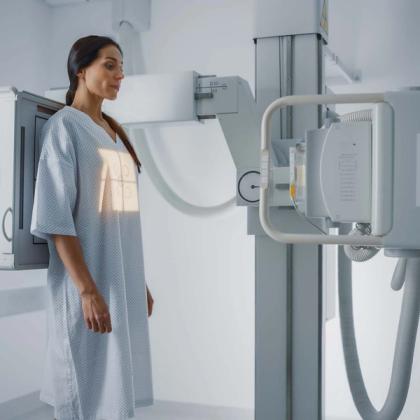This podcast episode is worth 0.27 CPD credits. Upgrade to Pro
Ep 126 – Are we doing enough chest X-rays in primary care?

Posted 10 Oct 2024
In this episode, Dr Hannah Rosa reflects upon the poor lung cancer survival rates in the UK. She asks whether we are doing enough chest X-rays in primary care and whether we could be detecting lung cancers earlier. She delves further into this by exploring why diagnosing lung cancer is challenging, reviewing the guidelines and latest research and then discussing when we should continue to investigate for lung cancer even if the patient has had a normal chest X-ray. She finishes by reviewing the targeted lung health check programme that is currently being rolled out across England.
Key references
- The Guardian. 2024. https://www.theguardian.com/society/2024/jan/11/uk-cancer-survival-rates-developed-world-report.
- Bradley SH, et al. Br J Gen Pract. 2021;72(714):e34-e42. doi: 10.3399/BJGP.2021.0232.
- Cancer Research UK. https://www.cancerresearchuk.org/health-professional.
- NICE. 2023.https://www.nice.org.uk/guidance/ng12.
- American Cancer Society. 2024. https://www.cancer.org/cancer/types/lung-cancer/detection-diagnosis-staging/detection.html.
- Lyratzopoulos G, et al. Lancet Oncol. 2012;13(4):353-365. doi: 10.1016/S1470-2045(12)70041-4.
- Hamilton W. Br J Cancer. 2009;101 Suppl 2(Suppl 2):S80-S86. doi: 10.1038/sj.bjc.6605396.
- Chowienczyk S, et al. Br J Gen Pract 2020;70(692):e193-e199. doi: 10.3399/bjgp20X708137.
- WebMD. 2024. https://www.webmd.com/lung-cancer/shoulder-pain-lung-cancer-link.
- Bradley SH, et al. BMJ 2022; 378 :e068384 doi:10.1136/bmj-2021-068384.
- Bradley SH, et al. Br J Gen Pract 2021;71(705): e280-e286. doi: 10.3399/bjgp20X713993.
- Public Health England. 2008 https://www.gov.uk/government/publications/medical-radiation-patient-doses/patient-dose-information-guidance/.
- Health Protection Agency. 2009. https://assets.publishing.service.gov.uk/media/5a7d9efa40f0b635051d048c/RCE-9_for_web.pdf.
- National Lung Screening Trial Research Team. N Engl J Med. 2013;368(21):1980-1991. doi: 10.1056/NEJMoa1209120.
- NHS. 2023. https://www.nhs.uk/conditions/lung-health-checks/.
- NHS England. 2024. https://www.england.nhs.uk/blog/rolling-out-targeted-lung-health-checks/.
- NHS England. https://www.england.nhs.uk/cancer/early-diagnosis/#targeted.
Key take-home points
- Lung cancer is the most common cause of cancer death in the UK, and survival has not shown much improvement in the past 50 years.
- More than 60% of lung cancers are caused by smoking. However, up to one quarter of lung cancers are diagnosed in people who have never smoked.
- Lung cancer often causes no symptoms or signs at an early stage, and when there are symptoms, people frequently mistake them as being due to other problems.
- Research reviewing lung cancer cases found that about one-third of patients presented three or more times before being referred.
- The NICE guideline on recognition and referral of suspected cancer advises that:
- If a patient over 40 years presents with unexplained haemoptysis, they should be urgently referred for a 2-week wait appointment, without waiting for a chest X-ray result.
- An urgent chest X-ray should be offered to assess for lung cancer or mesothelioma in patients over 40 years if they have two or more of the following unexplained symptoms, or if they have ever smoked or been exposed to asbestos, and they have one or more of the following unexplained symptoms: cough, fatigue, shortness of breath, chest pain, weight loss or appetite loss.
- An urgent chest X‑ray to assess for lung cancer should be considered in people aged 40 years and over with any of the following: persistent or recurrent chest infections, finger clubbing, supraclavicular lymphadenopathy or persistent cervical lymphadenopathy, or chest signs consistent with lung cancer or thrombocytosis.
- Chest X-rays have a sensitivity of 75% for picking up symptomatic lung cancer.
- When ordering chest X-rays, patients should be told to return to their GP if their symptoms are not improving, even if their chest X-ray has been normal, because they may still need further investigations. This is particularly important for those with high-risk symptoms or signs of lung cancer, as these patients will require an urgent referral, either directly for a computed tomography scan or via a 2-week wait.
- The CAPER (Cancer Prediction in Exeter) studies contain useful information relating to the positive predictive values of different symptoms in relation to lung cancer risk.
- With regards to pregnancy and chest X-rays, the Health Protection Agency advises that the risks for pregnant women from a chest X-ray are very low, with the risk of childhood cancer per examination being less than one in a million. It therefore states that chest X-rays can be carried out on pregnant women if they are clinically justified and the dose is kept to a minimum, consistent with the diagnostic requirements.
- Targeted lung health checks are being offered to people aged between 55 and 74 years who have ever smoked. They are currently only available in some areas, but the aim is that they will be available everywhere in England by 2029. The programme aims to improve rates of lung cancer diagnosis at an earlier stage, when it is much more treatable.
Create an account to add page annotations
Annotations allow you to add information to this page that would be handy to have on hand during a consultation. E.g. a website or number. This information will always show when you visit this page.